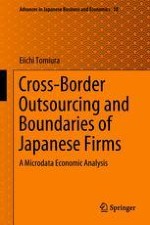2018 | OriginalPaper | Chapter
8. Capital, Labor, and Boundaries of Offshoring Firms
Author : Eiichi Tomiura
Published in: Cross-Border Outsourcing and Boundaries of Japanese Firms
Publisher: Springer Singapore
Activate our intelligent search to find suitable subject content or patents.
Select sections of text to find matching patents with Artificial Intelligence. powered by
Select sections of text to find additional relevant content using AI-assisted search. powered by
